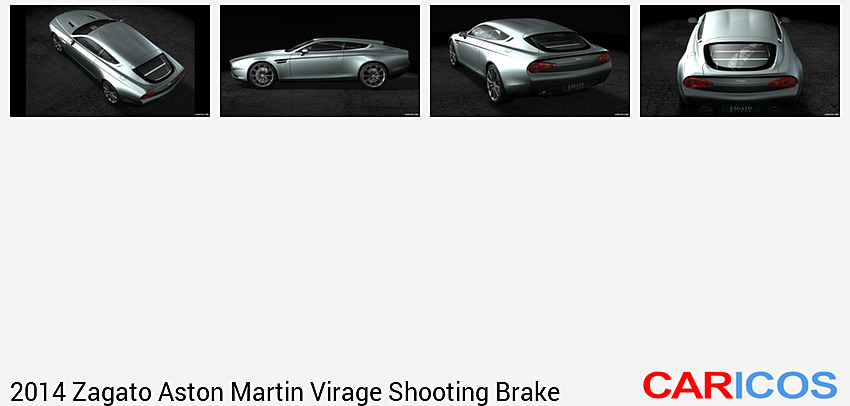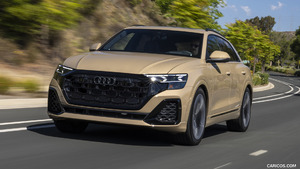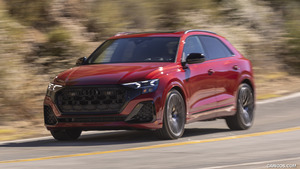Zagato Aston Martin Virage Shooting Brake
For Zagato, 2014 is a very important year. It commemorates 95 years of continuous activity, innovative design and three generations of Zagato family leadership.
Following the world debut of the Lamborghini 5-95 Zagato at the Concorso d’Eleganza Villa d’Este, Zagato Atelier continues celebrating its 95th anniversary with the grand debut of the Aston Martin Virage Shooting Brake Zagato at the Chantilly Art & Elegance. This mark’s Zagato’s second world premiere in 2014.
This one-of-a-kind car was commissioned by a European client who desired an atelier-level, collectible modern car. This project signifies:
- A bespoke Zagato design for an elite Aston Martin model with cutting-edge styling cues;
- It pays homage to Zagato’s artistic, Italian coachbuilding tradition on the canvas of a shooting brake body shape;
- The completion of the Aston Martin-Zagato centennial trilogy, which started in 2013 with the highly-acclaimed DBS Coupé Zagato Centennial and DB9 Spider Zagato Centennial, to celebrate 100 years of Aston Martin Lagonda Ltd.
TOP-OF-CLASS DESIGN PROPOSAL
The Aston Martin Virage Shooting Brake Zagato represents a new, exclusive creation for Aston Martin’s limited range of elite models. It represents a point break in traditional modern Aston design that has characterized all Zagato cars since the introduction of the DB7. A modern interpretation with design cues of the Aston Martin V8 Vantage and Volante of the mid 80s, the new Shooting Brake Zagato creates surprise and fascination with a new shape while maintaining Zagato and Aston Martin’s core design values.
COMPLETING THE TRILOGY
In 2013, Zagato Atelier paid tribute to Aston Martin’s 100th Anniversary with the announcement of the DB9 Spider Zagato Centennial, conceived for the well-known American car collector Peter Read, and the DBS Coupe Zagato Centennial, delivered to a young Japanese collector of modern Zagato cars. Both cars were officially shown for the first time on the 21st of July at Kensington Gardens in London during the official celebration.
After Zagato’s Coupé and Spider, the Shooting Brake marks the natural succession among the most appreciated body styles, both in the Italian and British tradition. As originally envisioned for Aston Martin’s Centennial, Zagato’s Trilogy arrives also in time with its own 95th Anniversary:
- Three different Aston Martin donor cars: DBS, DB9 and VIRAGE.
- Three different models of body works: Coupè, Spider and Shooting Brake.
- Three clients from three different continents: Asia, America and Europe.
BRITISH ORIGIN, ITALIAN TRADITION
The Shooting Brake body has had different meanings throughout automotive history. Since the 60s, however, it commonly refers to a luxury coupé, rigorously-styled with two doors and a functional boot space. This body was created to accommodate drivers’ sport and leisure passions, such as hunting or golf, while providing the exciting driving experience of a fast and exclusive GT. Nearly all of the most prestigious English marques include a Shooting Brake model (or an “authorized” conversion) in their model line.
Aston Martin was a real pioneer in this field and has remained a trendsetter. After some conversions made during the 60s and the 70s by local coachbuilders and customizers on the DB5, DB6 and DBS basis, the company decided to engage in the particular niche of Shooting Brake design on its own starting in the early 90s. This was entrusted to the actual Aston Martin’s Customer Service Division, which managed special requests.
Despite its British origin, the Shooting Brake shape has always been highly valued in Italy and, therefore, all of the top Italian coachbuilders expressed their ability with this body style. For example: Fiat 130 Maremma by Pininfarina (1974), Ferrari 330 GTC 2+2 by Vignale (1965), Lamborghini Flying Star by Touring (1966), Aston Martin Jet 2 by Bertone (2004), Mercedes 230 SLX Shooting Brake by Frua (1964), Chrysler Plainsman Two-door Station Wagon by Ghia (1956) and Zagato itself with the Mercedes-Benz S600 V12 Shooting Brake (1995).
Since its founding in 1919, Zagato has mainly focused on sport and race cars. As a leading coachbuilder since the beginning with 2-door/2-seat coupé and spider variations, Andrea Zagato decided to re-interpret the sleek body of the Aston Martin Virage as a Shooting Brake under a “Milanese” design approach, in perfect accordance with the model’s outstanding performance capability.
95 YEARS OF ZAGATO
Ugo Zagato began his coachbuilding career in 1919 when he left the Officine Aeronautiche Pomilio, where he excelled for four years, to return to Milan to set up his own business. He did so with the bold intent of transferring sophisticated constructional techniques that combined lightness with strength from the aeronautic to the automotive sector.
The cars of the time were still bulky and heavy: conceiving them as lightweight structures, with a frame in sheet aluminium similar to an aircraft fuselage, was the true revolution initiated by Zagato. This change in direction came to represent a fundamental chapter in automotive history when taste and refinement shifted in Europe, as did the concept of functional design. Following an initial period of focus on luxury coach building for famous brands of the era, Zagato started producing light and streamlined race bodies in the late 20s, through which it became a leader in innovation.
ZAGATO AND ASTON MARTIN: AN EXTRORDINARY AND LONG-STANDING COLLABORATION
The first partnership between Aston Martin and Zagato came to fruition in 1960 after Aston Martin sought to remove even more weight from the very special DB4GT. In the search of an ever lighter and higher performance version, Aston Martin approached Zagato. Managing Director, Elio Zagato and Technical Director Gianni Zagato along with a talented team managed to draft the main designs of the DB4GT Zagato.
This exclusive racing GT car was showed in late 1960 at the London Motor Show and production began in early 1961. Of the original 19 DB4GT Zagato models built, all still survive and exist today within some of the worlds greatest car collections.
Twenty-five years later, the two companies joined forces again in 1986 to design and build a limited number of the V8 Vantage Zagato and then later the V8 Volante Zagato.
A more recent project took place with the design and production of the Aston Martin DB7 Zagato. Launched to the world at the Paris Motor Show in 2002 with production following in 2003, 99 examples were built. A great deal of interest was shown by customers in the United States for a version suited specifically to the climates of Florida and California, and thus the collaboration was extended to produce an identical number of DB-AR1 (American Roadster 1).
The collaboration was revived again in 2004 with the Vanquish Roadster. This very special, one-off automobile continues to demonstrate how Zagato’s philosophy perfectly suits a roadster body with extreme mechanics.
Then, in 2011, the Aston Martin V12 Zagato, the car who celebrated 50 years of this relationship, was introduced in Villa d’Este as a race prototype and won the Design Award for Concept Cars and Prototypes.
After a month, two cars competed in the Nurburgring 24 Hours but, at the same time, Zagato and Aston Martin started designing its road-going version. The final result, the Aston Martin V12 Zagato was shown to the public at 2012 Kuwait Concours and, as a European Premiere, at the Geneva Motor Show. Deliveries started in late 2012.









